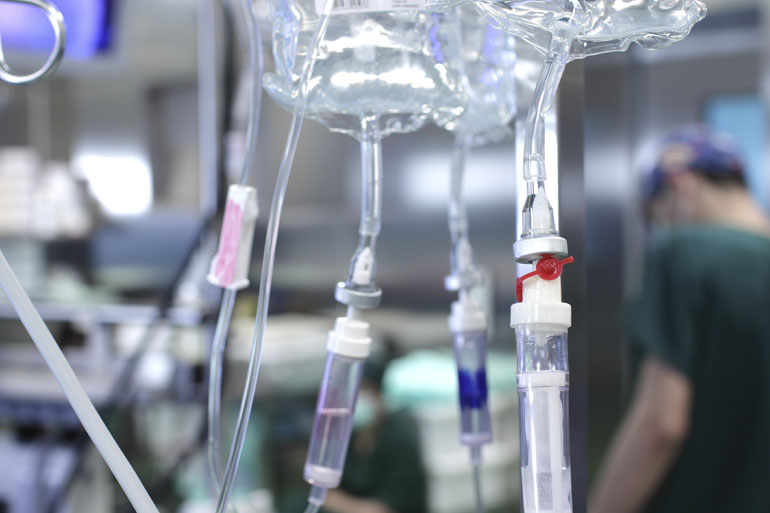Hospitals are getting slammed by drug price hikes that often have nothing to do with improving patient health, a new report has found.
Inpatient drug spending increased by 23.4 percent annually from 2013 to 2015, compared with 9.9 percent annual increases on retail drug spending during the same period, according to a new report by National Opinion Research Center (NORC) at the University of Chicago, which was commissioned by the American Hospital Association and the Federation of American Hospitals. Spending was driven by increases in drug unit prices rather than an increase in the volume of drugs used, they found.
“It would be one thing if price increases were associated with clear and important clinical improvements, but they’re not,” Chip Kahn, CEO of the federation, said Tuesday in a press briefing.
The price hikes driving the spending increases “appear to be random and inconsistent from one year to the next,” the researchers wrote. About half of the drug price hikes in the report occurred in drugs with no generic competitors.
“Drugs that were around for decades — almost a century, sometimes — caught us off guard,” said Scott Knoer, chief pharmacy officer of the Cleveland Clinic, referring to price hikes for drugs such as nitroprusside, which increased 672 percent per unit from 2013 to 2015, according to the report. “For a long time, old generic drug prices were so stable we didn’t even think about that,” said Knoer, who participated in the press briefing.
The brand name version of nitroprusside, Nitropress, was originally approved in 1981 to treat cardiovascular patients. Today, it’s made by just one company, Valeant Pharmaceuticals, which bought it in early 2015, and pushed the price to $790.46 per unit from $150 per unit, according to the report. The price hike has been the subject of Congressional attention.
Nitroprusside cost hospitals almost $95 million in 2015 up from $48.3 million the year before, according to the report.
“We understand the value of innovation,” said Rick Pollack, the American Hospital Association’s president and CEO. “However an unaffordable drug is not a lifesaving drug and a price increase resulting from market manipulation is simply wrong.”
The Pharmaceutical Research and Manufacturers of America (PhRMA) said the report misses the big picture by honing in on the drugs in the report, and it leaves out the fact that hospitals mark up drug prices when they bill patients.
“Focusing on a set of unrepresentative, older and off-patent medicines at a time when new generic drug applications had a record backlog gives a distorted portrayal of medicine spending,” said PhRMA spokesperson Holly Campbell.
The Generic Pharmaceutical Association was not available for comment.
The report included a national web-based survey with responses from 712 community hospitals from April through June of 2016. Researchers then weighted these responses to come up with estimates for 4,369 community hospitals in the United States. The analysis also included aggregate data for 28 drugs from two group-purchasing organizations, or GPOs, which buy drugs in bulk to negotiate better costs. The two GPOs represent 1,400 community hospitals.
More than 90 percent of survey respondents said drug price hikes had a “moderate or severe” impact on their budgets. What’s more, Medicare reimbursements often don’t reflect increased inpatient drug costs because the reimbursements are based on price indexes, and drug prices are rising too fast for the indexes to keep up.
“The bottom line is if you spend several million dollars more on drugs, it’s just accounting. You’re going to spend several million dollars less on other things,” Knoer said, adding that although this is not a problem for Cleveland Clinic, some hospitals aren’t able to hire has many nurses or can’t invest in the latest screening technologies as a result of increased drug spending.
David Vandewater, president and CEO of Ardent Health, which includes 14 hospitals, pointed out that hospital closures seem to be more common than ever before. And although greedy drug companies aren’t 100 percent at fault, they may share some of the blame for this trend, he said.
When companies hike drug prices, hospitals lose money on insured patients, but make money on uninsured or out-of-network patients because they can legally charge a markup for drugs, said Gerard Anderson, a health policy and management professor at Johns Hopkins Bloomberg School of Public Health. Drugs are regularly marked up at least 500 percent, so if the drug price is higher, so is the profit.
“It’s not a total loss to them when prices go up because charged payers make up some of the difference,” Anderson said. He was not involved in the report or on the press call.
Ultimately, even healthy individuals wind up paying the price for out-of-control drug costs, in the form of higher premiums and copays, increased deductibles and higher taxes, Knoer said on the press call.
“If these kinds of increases took place in the sale of gasoline in the U.S., you’d be paying $30 a gallon,” Vandewater said. “And if that was the case, the federal government or somebody would decide enough is enough.”
KHN’s coverageof prescription drug development, costs and pricing is supported in part by the Laura and John Arnold Foundation, and coverage related to aging & improving care of older adults is supported by The John A. Hartford Foundation.







